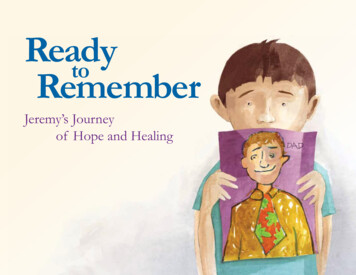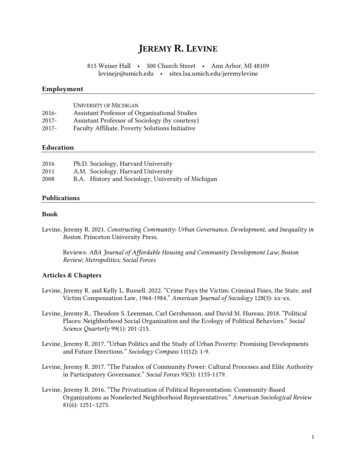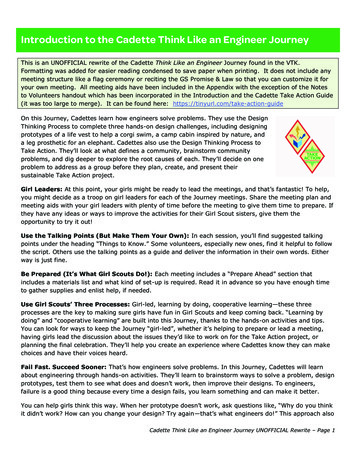
Transcription
ReadytoRememberJeremy’s Journeyof Hope and Healing
Jeremy loved art. It had always been his favorite subject in school. But lately theten-year-old boy couldn’t even pick up a paintbrush. Today, in art class, he juststared at his blank paper.“Do you need some ideas for your sketch?” Mr. Davis asked.“Nah, I just don’t feel like drawing,” Jeremy replied. The boy’s artwork used tocover the walls of the classroom. Now Jeremy just didn’t seem interested.“I’d rather read my book,” he told Mr. Davis.1
After school, Jeremy’s mother picked up Jeremy and hisyounger brother. Brandon jumped into the back seat. Jeremy’sbrother was in second grade. He turned eight three months ago,just a few weeks before that horrible day.“Woo-hoo, it’s the weekend!” yelled Brandon. “Fridays rule!”“It’s finally warming up,” said their mother. “Do you boyswant to go to the skatepark tomorrow?”“Yes!” said Brandon.“I can’t,” Jeremy said, looking out the window. “I needto study.”2“But it’s the weekend. You can take some time out for a littlefun, can’t you, honey?” asked Jeremy’s mom.“NO!” Jeremy snapped. “I have a math test coming up.Don’t you remember that I got a C-minus on the last one?”Jeremy’s grades were way down. Until recently, he always gotstraight As in school.“That’s okay, Jeremy,” said Brandon. “We can skateboardanother time.”
When they got home, Jeremy went straight to his room.His brother followed him.“Hey, Jer, do you want to play a video game or something?”Brandon asked.“Um . . . maybe,” said Jeremy.Brandon was excited. “Cool! Let’s play the one Dad gave me for mybirthday! Let’s go downstairs!”“Hold on!” Jeremy said, changing his mind. “I’m not in the mood.I really want to finish my book.”Brandon looked at his big brother. He loved hanging out with Jeremy,but lately he felt like a big pest. Jeremy always wanted to be alone.His friends didn’t even come over anymore.3
At dinner that night, the boys’ mom served homemade pizza.“Can I have another piece, Mom?” Brandon asked, poppinga piece of pepperoni into his mouth. “Do you guys rememberthat time last year when Dad was making one of his super-duperpizzas? He threw the pizza dough in the air like real pizza chefsdo but it landed on the toaster!” Brandon laughed at thememory. “And he just scraped it off and used it! GROSS!”Their mom laughed along with Brandon. Jeremy jumped upfrom the table, knocking his glass of juice onto the floor.4“Why do you two keep talking about Dad?” he yelled.“Haven’t you noticed? HE’S NOT HERE ANYMORE! Whocares about some stupid pizza he made?”Jeremy didn’t want to hear stories about his dad, he missedhim too much. Why couldn’t his mother and brother understandthat?“Jeremy . . .” his mother called out.“I’m not hungry! I’m going upstairs to read,” Jeremy said ashe dashed to his room and slammed the door behind him.
Jeremy tried to read his book but the words just blurred together.How can they talk about Dad as if nothing happened, he wondered.Don’t they even care that he’s gone?Whenever someone mentioned his father, even a happy memory,all Jeremy could think about was the awful way that he died.Now, every time Brandon or his mom brought up a story abouthis dad, Jeremy just felt scared. He had so many awful dreams abouthis father’s death that he was afraid to go to sleep.5
When Jeremy was seven, his father gave him his first set ofcolored pencils. There were 64 pencils in the set, more colorsthan he had ever seen. He and his dad loved to draw picturestogether. They used to make funny portraits of each other.His dad also taught Jeremy and Brandon how to skateboard.He may have been the oldest person at the skatepark, but hecould do an ollie-jump and kickflip better than most of the kids.6Whenever Jeremy saw the colored pencils or his skateboard,they reminded him of his father and the terrible way he died.His stomach started hurting and he often felt like throwing up.Jeremy thought it was his fault that his dad died. He shouldhave known something bad was going to happen and warnedhis father. It was easier to just stay away from anything thatreminded him of his dad.
Jeremy’s mom came upstairs to talk to him. She sat onthe edge of his bed.“I know how much you miss Dad, sweetie,” his momsaid. “We all do.”“I should have stopped him from going out that day,”Jeremy said, still staring at the pages of his book.“Oh, honey, there’s nothing you or any of us could havedone. Sometimes bad things just happen. You had nothingto do with it!”“I don’t feel so good, Mom,” Jeremy said, shutting hiseyes. When he thought about his dad, his heart would beatso hard it felt like it was going to jump out of his chest. Andnow he was worried all the time about his mom, too. Wouldsomething happen to her?“I have that stomach ache again,” Jeremy said, grabbinghis belly.“Oh, son, I’m worried that it’s not going away. I thinkwe need to go see Dr. Chung again. Maybe she can figureout how to make it better.”7
The next day, Jeremy’s mother took him to the doctor’soffice. Dr. Chung examined Jeremy and talked to him for a longtime. She said that she wanted to send him to a friend of herswho was a different kind of expert, a counselor who helpedpeople with their feelings.8“Jeremy, would you be willing to talk to my friend? I thinkshe’ll be able to help you with your stomach ache.”“I guess so,” Jeremy said. He was worried that the counselorwould make him talk about his dad and he did NOT want todo that.
A few days later, Jeremy and his mother got to hisappointment early. A girl and her dad were leaving as Jeremywalked into the waiting room. When Jeremy looked up, he wassurprised to see it was someone he knew. Elena was a gradeabove him, and one of the star soccer players at his school.He remembered that she made the winning goal at the finalslast year. The girl saw him and waved.“You’re Jeremy, right?” the girl said. “I’m Elena.”Jeremy just looked down at this feet. He didn’t feel liketalking to Elena right now. He was thinking about going into see the counselor. Jeremy didn’t say much during his firstsession. He was relieved she didn’t make him talk a lotabout his dad.9
A few weeks later in school, Jeremy was eating lunchby himself when he spotted Elena. The girl came overto Jeremy’s table.“I was so sorry to hear that your father died,”Elena said softly. “My mom died last year and I knowhow hard it is. ”Jeremy felt a little sick when Elena mentioned hisdad. But he also knew she understood what he was goingthrough.“I used to be so scared and confused all the time,”Elena said, setting her tray of food down across fromJeremy. “One time my dad took me and my brother toa restaurant we used to go to with my mom. I totallyflipped out. I refused to walk into the place.”“Yeah, I’ve done stuff like that, too,” Jeremy said.“Mostly I tried not to have any feelings at all,” Elenacontinued. “It’s like I stuffed them all into a jack-in-thebox. Every once in a while the jack-in-the-box would getso full it would explode and all sorts of feelings wouldcome flying out!”“I know what you mean,” Jeremy said.10
“I remember one time after my mom died when my dad wanted meto clean my room,” Elena continued. “I don’t know why that made memad. I slammed my door so hard that a picture fell off the wall! Mydad was upset and said, ‘your mother would know what to do.’ Thatjust made me madder. But instead of yelling, I started crying. My dadhugged me and started crying, too. He said that maybe we needed somehelp to figure out how not to be so mad and scared all the time. That’swhen I started going to the counselor.”“And did it help you?” Jeremy asked.“Yeah, a lot,” said Elena. “I was finally able to talk about my momand how she died. I used to blame myself. Now I get that I had nothingto do with it. I learned things I could do to help feel better like pretending I was blowing up a big balloon in my belly. That helped me relax.”“Yeah, my mom did that trick with me last night at bedtime,”Jeremy said. “It helped me calm down. Sometimes when I go to sleepI can’t stop thinking of the way my dad died.”“I used to feel like all the scary stuff that happened was supergluedto my good memories. Now they’re finally unstuck!”Jeremy thought it would be great to think about his dad withoutfeeling so scared.11
The following week, Jeremy did talk to the counselor about his dad.He saw her several more times and then began to feel better. One day,he realized that his stomach didn’t hurt anymore.A couple of months later, Jeremy started going to the skatepark withBrandon. He even taught his brother how to do his dad’s killer kickflip!12
In school, Jeremy began drawing again. One day he drew a portraitof his dad wearing the funny tie that Jeremy had hand-painted for Father’sDay when he was in first grade.When he showed the picture to his mother, he saw that she had tearsin her eyes.“I’m sorry if it upsets you, Mom,” Jeremy said.“Oh no, honey, I love it!” his mother replied, wiping a tear away.“It looks just like Dad! I’m going to frame it and hang it in the living roomso we can see it every day!”Jeremy and his mom hugged each other. He still felt very sad about hisfather but now he was able to smile when he remembered the good timesthey had together.13
The counselor suggested that Jeremy and his brother thinkof a way to honor their father’s birthday that summer. The boysdecided to have a pizza party and to make one of their father’ssuper-duper pizzas with everything on it. Jeremy invited Elenato the party.Jeremy showed Elena how to toss the pizza dough into theair just like his father used to. She tried to catch the dough, butit fell onto their toaster, making a big mess.14Elena felt bad at first, but Jeremy and his family burstinto laughter.“Don’t worry, Elena,” Jeremy said, still laughing. “The samething happened to my dad!”Jeremy’s mom scraped the dough off of the toaster andplopped it in the pizza pan.They all enjoyed a delicious dinner. Jeremy and Brandondecided to have a pizza party every year to remember their dad.
CAREGIVER GUIDEIntroductionHow to use this bookReady to Remember tells the story of Jeremy, a boy sufferingfrom Childhood Traumatic Grief. When a parent, sibling, or otherimportant person dies, children can have varied reactions. Mostchildren feel sad and miss the person who died, but they also feelcomfort thinking or talking about that person. This is typical grief.In Ready to Remember, Jeremy’s brother Brandon has typical grief.He likes talking about his dad and participating in activities they didtogether. Jeremy is different. He does not want to join conversations or do things related to his dad because they bring back scaryfeelings and remind him of the awful way his father died.Children can develop Childhood Traumatic Grief (CTG) whenthe death is violent or unexpected, such as from an accident,natural disaster, murder, suicide, or act of war. But they can alsodevelop CTG when the death does not seem shocking to adultssuch as a death that occurs after a long illness.When children such as Jeremy have CTG, their trauma reactionsinterfere with their ability to go through the typical bereavementprocess. Any thoughts, even happy ones, of the person who diedcan lead to frightening memories of how the person died. Becausethese thoughts can be so upsetting, the child often tries to avoidall reminders of the death, or of the person, so as not to get upsetand overwhelmed. In Ready to Remember, Jeremy is stuck on thetraumatic aspects of his father’s death, making it hard for him todo things with his family, be with friends, and work in school.You can use this book in many ways. In this story, we do notdescribe the specific way that Jeremy’s father died because we wantchildren with CTG to be able to relate the story to their ownexperience. We hope you use Jeremy’s story as a starting point totalk about your family’s experience. You may read the book withyour child, or your child may read it alone. Either way, it may behelpful to engage your child in a discussion about the story and foryou to talk about your own feelings too. For example, whenparents share that they felt angry or abandoned after a death, orsad or scared when talking about the person who died, this canmake it easier for children to acknowledge their own feelings.It is important to let your child know that there is no one rightway to grieve; you can handle hearing about any and all of yourchild’s feelings. A child who does not want to read the book, says“I know all that” or “I never feel that way” may be coping wellwith grief. Alternately, this may be a sign that your child is tryingvery hard to avoid talking about the death and needs yourencouragement to discuss feelings. A child who is having a greatdeal of difficulty coping may need the guidance of a mentalhealth expert.The following more detailed information is provided to helpyou know if your child might be suffering from CTG and offerssuggestions on how you can help.15
16What is Childhood Traumatic Grief ?Common Signs of Childhood Traumatic GriefAfter a death that is shocking, sudden, or terrifying(“traumatic”) many children adjust well. However, some childrencan develop CTG. Children may also develop CTG even after adeath that did not seem traumatic or frightening to you. This canhappen for different reasons. For example, a child may be confusedabout why or how the person died. A child may be surprised by adeath or disturbed by seeing a person suffer or physically decline.A child does not have to have been present or to have witnessedwhat happened to develop CTG. Whether a child was told whathappened, saw what happened, or only imagines what happened,scary and disturbing thoughts and images of how a person lookedor died may keep coming up in the child’s mind.In the beginning of Ready to Remember, Jeremy does not wantto draw pictures because it brings back memories of his dad’sgiving him his first set of drawing pencils. He also does not wantto go skateboarding with his brother Brandon. Memories andactivities related to his dad bring back awful feelings about hisfather’s death. But avoiding topics, places, and things related tothe person who died or what happened doesn’t make the fears andworries go away. Since Jeremy’s problems have been going on for awhile, his mom is right to be concerned. In the first several weeksafter a death, many children have difficulties as they struggle toadjust to the loss of an important person. But if your childcontinues to show some of the same signs as Jeremy or Elena afew months after the death, he or she may have CTG. Thiscondition may not be apparent until a year or even longer afterthe death.CTG reactions may be hard to notice from the outside, butthoughts and feelings on the inside are often communicated bybehavior in the following ways.Intrusive memories: These can show up as nightmares,repeated play about what happened, or a child’s blaming him - orherself for a death. Grieving children may have bad dreams orfeel guilty, but a child with CTG cannot seem to let go of thesethoughts and images. They interfere with the child’s life and donot stop when you try to reassure the child or correct the child’smistaken beliefs about how or why the death happened. “He hadso many awful dreams about his father’s death that he was afraid togo to sleep” (page 5)Feeling responsible for the death, or as if the child couldhave prevented it: Some children may feel inappropriate selfblame or guilt about the person’s death. They sometimes believethat if only they had done something differently, the person wouldstill be alive. Sometimes self-blame is expressed through the beliefthat there were warning signs (“omens”) that the person would die,and if the child had only seen the warning signs, the person couldhave been saved. “He should have known something bad was going tohappen and warned his father.” (page 6)Avoidance and numbing: A child may withdraw from friends,act as if not upset, or avoid reminders of the person or the way theperson died. By trying to avoid painful feelings, the child ends upavoiding many other feelings, even positive ones. “Mostly I tried notto have any feelings at all,” Elena continued. “It’s like I stuffed themall into a jack-in-the box.” (page 10)
Physical reactions: Some children develop physical symptomsor express their upset through their bodies. Whenever Jeremy sawthe colored pencils or his skateboard, they reminded him of his fatherand the terrible way he died. His stomach started hurting and he oftenfelt like throwing up. (page 6)Emotional reactions: Children may be irritable, angry, oranxious. They may seem on alert or worried about their own orother people’s safety. When hearing people joke or reminisce abouthappy memories children can get upset. “Why do you two keeptalking about Dad?” he yelled. “Haven’t you noticed? HE’S NOTHERE ANYMORE! Who cares about some stupid pizza hemade?” (page 4)These reactions can make it difficult to do everyday activitieslike eat, sleep, pay attention in school, or be with friends. Inaddition, things that remind the child of the person or the person’sdeath can trigger upsetting reactions.Loss reminders: People, places, things, or situations thatremind the child of the person who died can be disturbing.“I remember one time after my mom died when my dad wanted me toclean my room,” Elena continued. “I don’t know why that made memad. I slammed my door so hard that a picture fell off the wall! Mydad was upset and said, ‘your mother would know what to do.’ Thatjust made me madder. (page 11)Trauma reminders: These are reminders related to the waythe person died. For example, if the person died in a car accident, achild may be scared or refuse to ride in a car. A child whose specialperson died in a flood may panic when hearing thunder.Life changes after the death that can contribute toChildhood Traumatic Grief: Other challenges and stresses thatoccur as a result of the death can put a child at increased risk fordeveloping CTG. For example, a death may mean that a previouslystay-at-home mom has to start working full time, resulting in newchildcare and afterschool arrangements. A child who witnessed amurder may face legal procedures, media attention, and unpleasantquestions from peers. A grieving military family may have to moveoff base, leave their support network, and make new friends. Thesetypes of changes can add to the child’s stress and make grievingmore difficult.How can I tell if my child has ChildhoodTraumatic Grief ?The following questions can help you understand if your childis having a traumatic reaction to the death of someone special. Ifyour child experiences some or all of these symptoms for a fewmonths or more after the person died, they happen many times,are very severe, or you are not sure, check with a professional.1) Does your child have nightmares or problems sleeping?2) Does your child keep playing out, drawing, or dreaming aboutwhat happened?3) Does your child have more physical complaints?4) Is your child having difficulty in school?5) Is your child having trouble concentrating when reading or evenwhen doing fun activities like video games?17
6) Is your child jumpy or easily startled?7) Does your child avoid talking about the person who died, goingplaces, or engaging in activities that are reminders of the person?8) Is your child more withdrawn and less joyful or not doing activities he or she liked to do?9) Does your child have excessive worry about something else badhappening or worry about being away from you?10) Does your child talk about being responsible for the death?11) Is your child more angry or irritable?How can I help my child or teen?You are critically important in helping your child or teen withCTG. The first step is to recognize when your child is havingdifficulty. Keep these points in mind to help your child.Children are different. Not all children who experience adeath as sudden or shocking will develop CTG. Reactions can varyaccording to a child’s age, developmental level, temperament, andprior history of learning differences, emotional challenges, andtraumatic experiences. CTG may appear differently in differentchildren.Help your child understand Childhood Traumatic Grief.If you are concerned that your child is having a traumatic reaction,let your child know that you realize that he or she is struggling.Reading this book together and talking about it can validate achild’s feelings and be a relief that help is available. You can ask ifyour child ever feels like Jeremy or Elena.18Pay attention to reminders. Keep an eye out for remindersthat may be difficult for your child. A child who gets overly upsetor angry, indifferent, or shuts down when seeing things associatedwith the person or the way the person died, or shows difficulty onimportant days that were special with the person such asThanksgiving, may be having a traumatic reaction.Get more help. Reach out for professional help if you’reconcerned that a child’s reactions are affecting his or her daily life.Children or teens experiencing traumatic reactions can benefitfrom getting the right kind of help. Working with a mental healthprofessional or counselor can help children learn how to expressand manage strong reactions, develop healthy stress reductionstrategies, tell their stories in a safe way, learn positive ways tocope with their reactions, learn not to be afraid, and recall andshare happy memories of someone special. “I used to feel like allthe scary stuff that happened was superglued to my good memories.Now they’re finally unstuck! “ Jeremy thought it would be great tothink about his dad without feeling so scared . . . The following weekJeremy did talk to the counselor about his dad. He saw her severalmore times and then began to feel better. One day he realized that hisstomach didn’t hurt anymore. (pages 11-12)
Help is availableMore information about Childhood Traumatic Grief and howto differentiate CTG from typical childhood grief is available atwww.nctsn.org.Go to or books and resources for children, teens, caregivers and professionals.There is also information about such specific situations as death relatedto military service and the loss of a sibling. There are materials geared todifferent audiences, such as teachers, and in Spanish as well as English.For additional help, you can send an e-mail to info@nctsn.org.
This project was funded by the Substance Abuse and Mental Health Services Administration (SAMHSA), US Department of Healthand Human Services (HHS). The views, policies, and opinions expressed are those of the authors and do not necessarily reflect thoseof SAMHSA or HHS.This product was conceptualized and developed by the Child Traumatic Grief Committee of the National Child Traumatic StressNetwork (www.nctsn.org). Established by Congress in 2000, the National Child Traumatic Stress Network (NCTSN) brings a singularand comprehensive focus to childhood trauma. NCTSN’s collaboration of frontline providers, researchers, and families is committed toraising the standard of care while increasing access to services. Combining knowledge of child development, expertise in the full rangeof child traumatic experiences, and dedication to evidence-based practices, the NCTSN changes the course of children’s lives by changingthe course of their care.Story by Robin F. Goodman, Danny Miller, and Judith A. CohenEditing by Deborah A. LottIllustrations by Christopher H. MajorCaregiver Guide by Robin F. Goodman, Judith A. Cohen, and Sherri WilsonSuggested Citation:Goodman, R. F., Miller, D., Cohen, J. A. & Major, C. H. (2011). Ready to Remember: Jeremy’s Journey of Hope and Healing. Los Angeles,CA & Durham, NC: National Center for Child Traumatic Stress. 2011, The National Center for Child Traumatic Stress on behalf of, Robin F. Goodman, Daniel Miller, Judith A. Cohen, and Christopher Major. This work wasfunded by the Substance Abuse and Mental Health Services Administration (SAMHSA), US Department of Health and Human Services (HHS), which retains foritself and others acting on its behalf a nonexclusive, irrevocable worldwide license to reproduce, prepare derivative works, and distribute this work by or on behalfof the Government. All other rights are reserved by the copyright holder(s). This story may be copied and distributed free of charge, but may not be sold. It maynot be altered or excerpted without the express written permission of the primary author, DrRobinGoodman@aol.com.WWW.NCTSN.ORG19
Jeremy. "One time my dad took me and my brother to a restaurant we used to go to with my mom. I totally flipped out. I refused to walk into the place." "Yeah, I've done stuff like that, too," Jeremy said. "Mostly I tried not to have any feelings at all," Elena continued. "It's like I stuffed them all into a jack-in-the-box.










